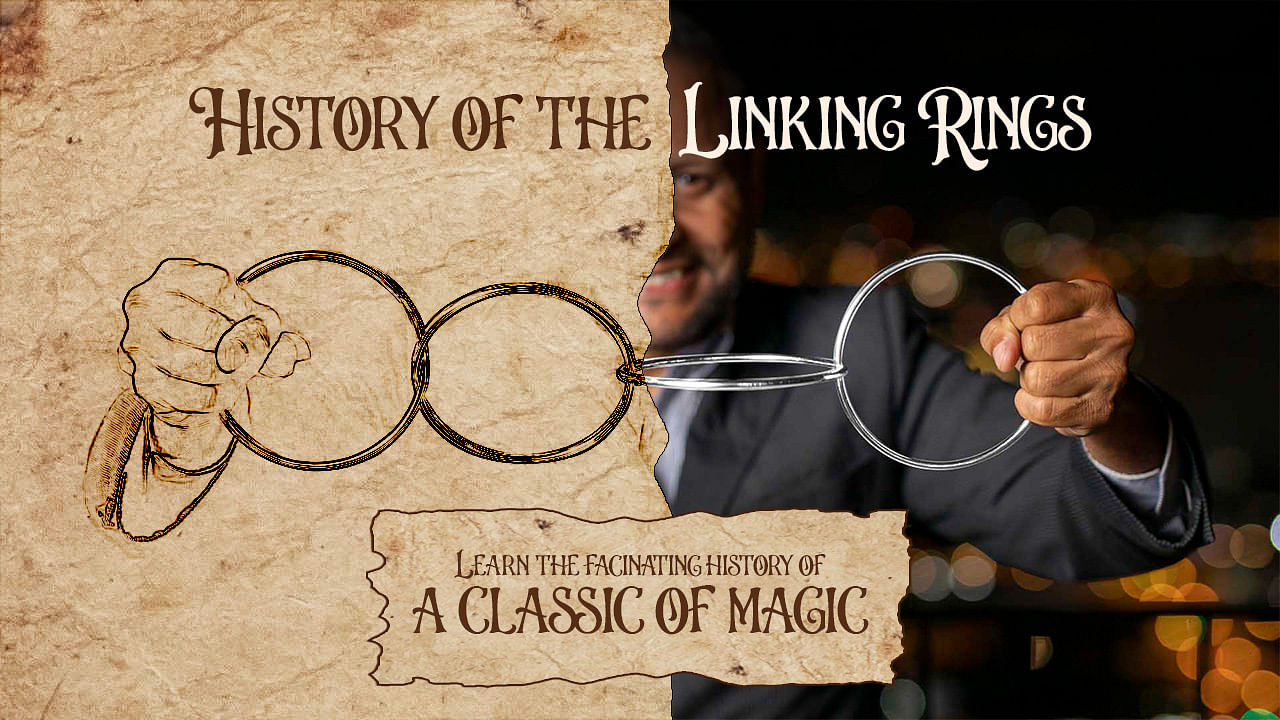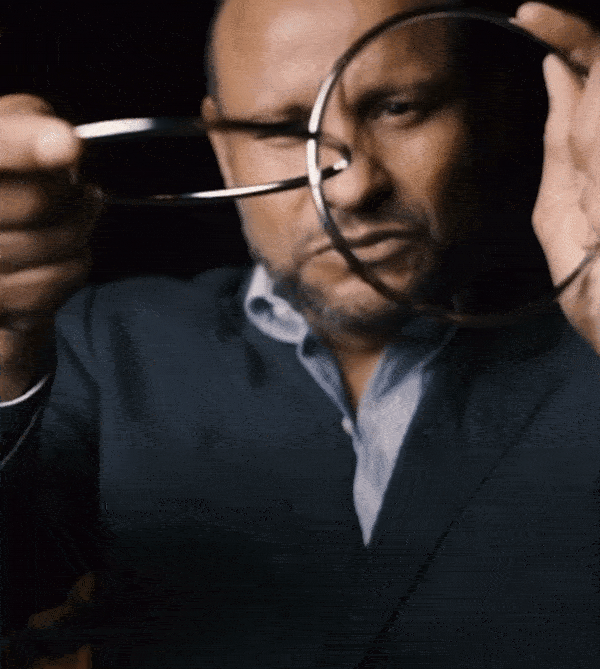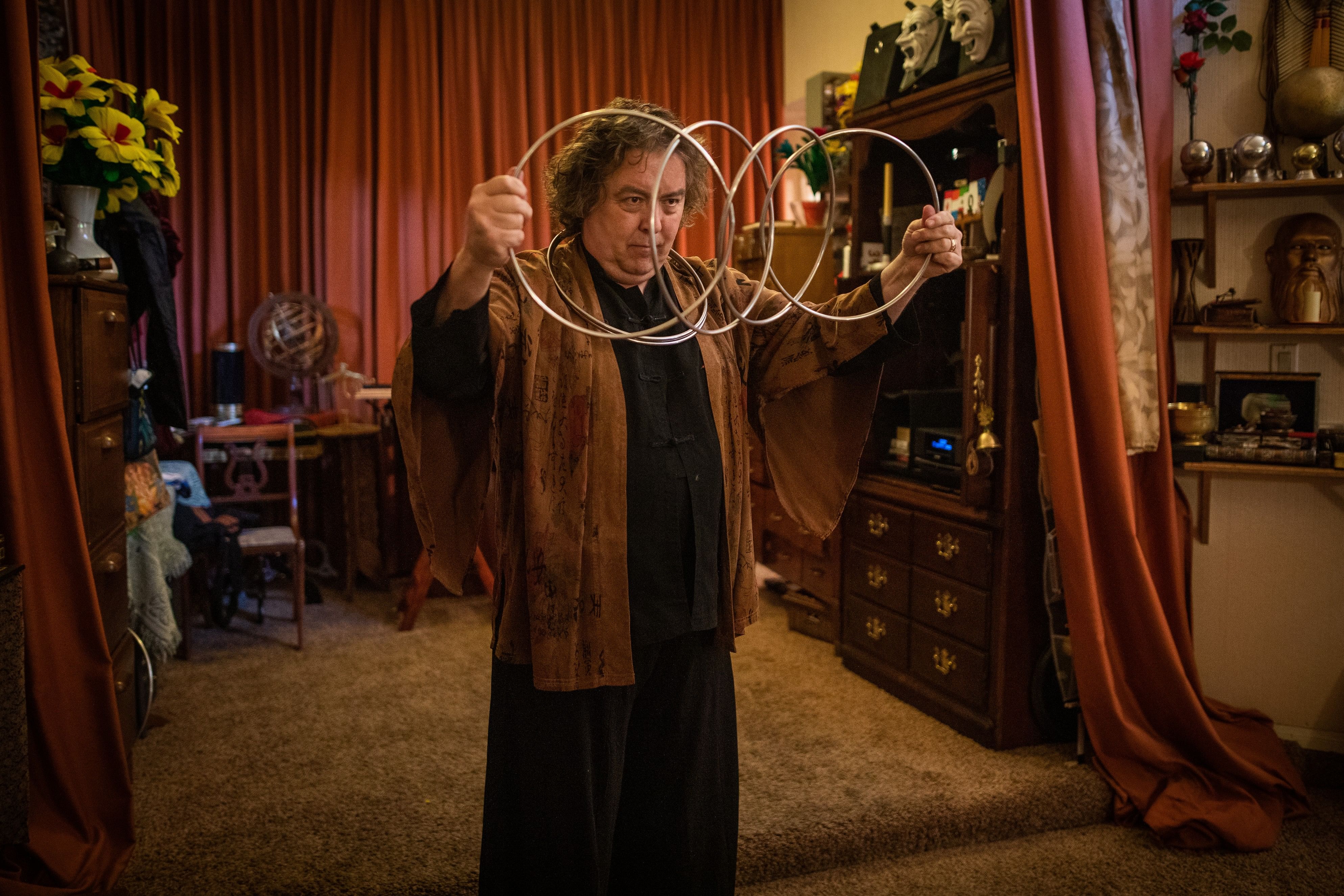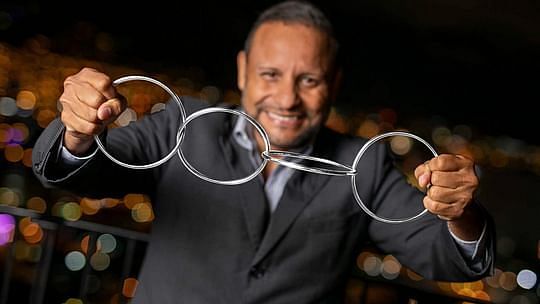A History of the Linking Rings
 It’s incredible to think that solid steel melting through solid steel could ever be considered anything short of a miracle. Yet, few magic tricks are more polarizing than the linking rings. While many magicians continue to dazzle audiences and pay the bills by “doing the rings”, others roll their eyes as soon as they hear that signature “clank” inside a magician’s case. For some, the linking rings are the epitome of the corny magician stereotype.
It’s incredible to think that solid steel melting through solid steel could ever be considered anything short of a miracle. Yet, few magic tricks are more polarizing than the linking rings. While many magicians continue to dazzle audiences and pay the bills by “doing the rings”, others roll their eyes as soon as they hear that signature “clank” inside a magician’s case. For some, the linking rings are the epitome of the corny magician stereotype.
 As a pseudo rite of passage for magicians, the linking rings have found themselves in the hands of many conjurors over the years—some great, some not so great. Yet, the subpar performance you saw at your 8th birthday party is not indicative of the linking rings as a whole.
As a pseudo rite of passage for magicians, the linking rings have found themselves in the hands of many conjurors over the years—some great, some not so great. Yet, the subpar performance you saw at your 8th birthday party is not indicative of the linking rings as a whole.
Despite the misconceptions surrounding the linking rings, countless professional magicians continue to perform them because, in the right hands, they can still be a true miracle. Just take a look at the new “Melero Rings” from underground Venezuelan magic legend Ernesto Melero. This set is one of the biggest leaps forward for the linking rings in years. Even though most magicians know the inner workings of the linking rings, they were still fooled when they first saw Ernesto perform his "Melero Rings" routine. This continued evolution is a major factor behind the sustained success of the linking rings.
In honor of this revolutionary debut, we’re taking a look back at the illustrious history of the linking rings and what the future holds for them.
What are the Linking Rings?
Once called “Chinese Linking Rings”, the linking rings is one of the most widely-recognized magic tricks ever created. In its most basic form, a variety of solid metal rings impossibly penetrate through each other, linking and unliking at the will of the magician. In some routines, the magician even allows the rings to be examined by members of the audience to help further prove the impossibility.
Throughout the years, many variations have been introduced including the popular close-up magic linking rings routines that inspired “Melero Rings” such as "McAbee Rings," “Ninja Rings” and “Messado Rings”. There have also been unique routines using objects other than the standard metal rings such as Mike Caveney’s “Linking Coat Hangers”, Richard Himber’s “Linking Finger Rings,” and Dick Zimmerman’s “Linking Hula Hoops”.
A Look Back at the History of the Linking Rings
It’s pretty ironic how the linking rings are one of the biggest clichés in magic—right up there with sawing a woman in half—yet nobody has been able to truly pin down when they first arrived in the annals of magic history. Some believe the linking rings are upwards of 2,000 years old, first appearing in the early 1st century in anywhere from Ancient Egypt to the Middle East, Rome, India, and China. Others believe in the theory popularized by French Magician “Philippe” (Jacques Andre Noel Talon) that the linking rings were first introduced in Europe in the early 19th century by a traveling troupe of Chinese Jugglers—hence the original name “Ancient Chinese Linking Rings.”
The thing about all these theories though is that they are just that—theories. They lack any sort of substantial evidence. In fact, most of the evidence about the origins of the linking rings was largely superficial until 2016 when world-famous mentalist and respected magic historian Max Maven made one of the biggest breakthroughs in the history of the linking rings.
In the May 2016 issue of Genii magazine, Maven penned a seminal article about a rare Japanese book called Hokasen that featured a routine called “The Iron Rings”. As this text was published in 1764, it is widely believed to be the earliest known written explanation of the linking rings. Maven also goes on to explain why the Japanese dubbed the rings as “Chinese”.
So, not only did we receive the most solid evidence ever seen about the origins of the linking rings, but we also learned at the same time that they were neither “ancient” nor “Chinese”. In essence, magicians experienced a remarkably meta moment as they realized that they had managed to fool themselves for years.

Linking Rings in the Modern Age
While the linking rings may have first appeared in print more than 250 years ago, it wasn’t until a century later that they truly started to gain popularity. Most magic historians credit the famous Chinese magician Ching Ling Foo with bringing the linking rings into the mainstream during his international tours in the late 1800s and early 1900s. Around this same time, Foo’s biggest competitor American magician Chung Ling Soo, and the man many believe to be the “father of modern magic”, Jean-Eugène Robert-Houdin, also made the linking rings a mainstay in their acts.
Since then, the linking rings have been regularly performed by some of the most famous and influential magicians in the world from Dai Vernon to Doug Henning, Jonathan Pendragon, Richard Ross, Jack Miller, Jeff McBride, Paul Daniels, Chris Capehart, Peter Samelson and David Copperfield. The official magazine of the International Brotherhood of Magicians is even named after the iconic prop.
How Many Linking Rings is too Many?
Despite being a physically rigid object, the linking rings offer a remarkable amount of flexibility for any performer. Everything from the sleight of hand moves you use, to the size of the rings, and even the amount of rings you include, can be adjusted to suit any personality. Despite being the same core effect, Dai Vernon’s elegant Symphony of the Rings is markedly different than “Lord of the Rings” Charlie Frye’s eccentric giant linking rings routine. And that’s what makes the Linking Rings so special!
This also means that trying to describe a “standard” linking ring routine is a pretty difficult task. “The Iron Rings” routine in Hokasen introduced the world to a three-phase routine with up to five rings. Chung Ling Soo used ten rings, while Ching Ling Foo and some European magicians used up to 12 or more. Over the years though, magicians have simplified the effect, creating popular routines with as few as three or even just two rings.
Today, most quality magic shops sell rings in sets of four or eight. In his book Roy Benson by Starlight Todd Levent mentions that he believes the popularity of using eight rings stems from a popular routine in the legendary magic book Modern Magic by Professor Hoffmann. Eight rings are also less expensive to produce, and are easier to carry, than 10 or 12—which would also very likely explain the recent trend of most magicians choosing to use four rings instead of eight.
Did you Know?
The Guinness World Record for the longest chain of linking rings is 534 rings. American Magician Monty Witt assembled 129 magicians at the Magic Convention for the International Brotherhood of Magicians in July 2004 to complete this monumental achievement.
What Sizes Linking Rings are Available?
For the most part, the linking rings used in stage performance routines range from 8 inches to 12 inches in diameter, with the latter being the most commonly used size. Larger sizes constructed of stainless steel tubing are also available, but aren’t often used these days. (although, if you watch the video of Charlie Frye below, you’ll realize why this is a shame.)
The most substantial evolution in recent years though has undoubtedly been the introduction of close-up linking rings. In 1973, R. Brooks Conner, previewed a close-up version of the Linking Rings at the PCAM convention where he presented smaller rings as "bracelets." The routine was later advertised his McAbee Rings (with quotes from Mike Skinner, Dai Vernon and more) as:
If you had seen Brooks Conner introduce this effect in his close-up act at the '73 P.C.A.M. Convention, you would have witnessed the ultimate in beauty and utter impossibility.
You would have seen three lovely gold bracelets link cleanly together while in a spectator's hands. Another spectator un-links two bracelets. The effect continues with the performer doing impossible and beautiful things with the bracelets.There is no key in evidence throughout the routine. The bracelets are actually linked beyond a shadow of a doubt. For the finale, the separate bracelets are PASSED OUT FOR EXAMINATION, with a microscope if you wish!
Prior to this, the linking rings were exclusively used by stage magicians. These portable rings brought the linking rings from the stage to a close-up setting, opening them up to an entirely new world of magicians. In particular, in 1988, Japanese magician Masahiro Yanagida changed the linking rings forever with the introduction of his “Ninja Rings”.
“Ninja Rings”, which were heavily championed by master sleight of hand artist Shoot Ogawa, eventually inspired Joshua Messado’s “Messado Rings”. Both of these were widely considered the industry standard for close-up linking rings until Ernesto Melero introduced his revolutionary “Melero Rings,” a special set of four seamless and scratch-resistant, chrome-plated iron rings with a never-before-seen gimmick that unlocks the ability to link and unlink the rings in ways that were previously deemed impossible. This includes, for the first time ever, being able to hold all four linked rings from the top ring with just your fingertips.
Why The Classics Of Magic Still Matter
 “Melero Rings” not only revolutionize the types of linking rings routines magicians can perform but also introduce a new generation of magicians to a chic and modern version of a classic magic effect. Although, with so many unbelievably powerful magic apps, downloads, and other gimmicks available, why would any magician want to use what some might consider an “outdated” prop?
“Melero Rings” not only revolutionize the types of linking rings routines magicians can perform but also introduce a new generation of magicians to a chic and modern version of a classic magic effect. Although, with so many unbelievably powerful magic apps, downloads, and other gimmicks available, why would any magician want to use what some might consider an “outdated” prop?
The answer is simple. The classics of magic are classics for a reason. They teach you the most important foundational aspects of magic and have been proven to captivate audiences. As Mark James proved during the Connected: Live virtual magic conference, they stand the test of time and even work in the new digital era magic currently finds itself in.
This might not be as obvious when you see a magician perform a classic effect the same way they have for 30 years, including the same stock lines and jokes. But those committed to continually evolving their routines, and valuing the cheers and applause of their audience over the jeers of their peers, will find great success in performing the classics of magic.
Learn the Linking Rings
Whether you’re a linking rings veteran or just getting started, “Melero Rings” are one of the best sets of close-up linking rings you can own. Their innovative design allows you to perform a variety of easy and advanced routines filled with truly impossible-looking visuals.
Buy "Melero Rings"
